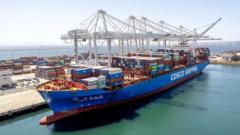In the wake of new U.S. tariffs, Canada's strategy includes protecting its economy while contemplating further retaliatory measures.
**Canada's Bold Response: Billions to Support Workers Amid Tariff Chaos**

**Canada's Bold Response: Billions to Support Workers Amid Tariff Chaos**
Canada promises substantial financial assistance for workers and businesses affected by U.S. tariffs, but specifics remain elusive.
April 9, 2025, 5:28 p.m. ET - In an escalating trade war, Canada has initiated a 25 percent tariff on vehicles imported from the United States, marking a significant response to the tariffs previously imposed by former President Trump. The estimated revenue from this action, approximately 8 billion Canadian dollars (roughly $5.7 billion), is earmarked for supporting Canadian businesses and workers who are facing instability due to these tariffs.
With no clear resolution to the ongoing tariff standoff, Canada's government is directing its resources toward minimizing the impact of potential job losses, factory closures, and corporate bankruptcies that the U.S. tariffs threaten to inflict. Countries like Spain and South Korea are also exploring relief measures to mitigate the economic fallout on their domestic industries.
The automotive sector, being Canada's largest export category after energy, is already experiencing immediate ramifications. Days before the new tariff took effect, Stellantis announced a temporary halt of operations at its assembly plant in Windsor, Ontario, which is projected to serve as a case study for assessing the future of the industry amidst these trade pressures. Flavio Volpe, head of the Automotive Parts Manufacturers' Association of Canada, estimated that approximately 12,000 workers—both in Canada and at Canadian-owned facilities in the U.S.—have faced layoffs due to the Stellantis shutdown, underscoring the deep and immediate economic impact of these evolving trade tensions.
With no clear resolution to the ongoing tariff standoff, Canada's government is directing its resources toward minimizing the impact of potential job losses, factory closures, and corporate bankruptcies that the U.S. tariffs threaten to inflict. Countries like Spain and South Korea are also exploring relief measures to mitigate the economic fallout on their domestic industries.
The automotive sector, being Canada's largest export category after energy, is already experiencing immediate ramifications. Days before the new tariff took effect, Stellantis announced a temporary halt of operations at its assembly plant in Windsor, Ontario, which is projected to serve as a case study for assessing the future of the industry amidst these trade pressures. Flavio Volpe, head of the Automotive Parts Manufacturers' Association of Canada, estimated that approximately 12,000 workers—both in Canada and at Canadian-owned facilities in the U.S.—have faced layoffs due to the Stellantis shutdown, underscoring the deep and immediate economic impact of these evolving trade tensions.





















